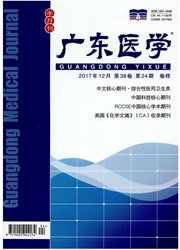

 中文摘要:
中文摘要:
目的观察丙泊酚或依托咪酯对出生28 d大鼠海马胶质纤维酸性蛋白(glial fibrillary acidic pro-tein,GFAP)、蛋白激酶A(protein kinase A,PKA)和环磷酸腺苷反应元件结合蛋白(cyclic AMP response elementbinding protein,CREB)表达的影响。方法选取雄性SD大鼠60只,随机分为对照组、丙泊酚组和依托咪酯组,每组20只。丙泊酚组腹腔注射丙泊酚总量为200 mg/kg,依托咪酯组腹腔注射依托咪酯总量为60 mg/kg,对照组不注射任何药物。血气分析仪检测大鼠动脉血呼吸和代谢指标的变化,免疫组织化学染色法检测大鼠海马组织中GFAP的表达,并应用半定量逆转录-聚合酶链反应(RT-PCR)方法检测大鼠海马组织中PKA和CREB mRNA的表达。结果各组大鼠动脉血pH值、氧分压、二氧化碳分压、HCO3-、BE、氧饱和度之间比较差异无统计学意义(P〉0.05);丙泊酚组与依托咪酯组GFAP的平均积分光密度值均高于对照组(P〈0.05),而丙泊酚组与依托咪酯组比较差异无统计学意义(P〉0.05);与对照组比较,丙泊酚组与依托咪酯组PKA和CREB mRNA的表达均降低(P〈0.05),丙泊酚组与依托咪酯组比较差异无统计学意义(P〉0.05)。结论丙泊酚或依托咪酯可能通过抑制PKA-CREB信号通路而损害大鼠海马神经元,使星形胶质细胞反应性增生、GFAP表达增加。
 英文摘要:
英文摘要:
Objective To investigate the effects of propofol or etomidate on expression of Glial fibrillary acidic protein (GFAP) , protein kinase A (PKA) and cAMP response element binding protein (CREB) in hippocampus of rats. Methods Sixty male Sprague Dawley rats aged 28 days were randomly divided into 3 groups (n = 20 each). The rats in propofot group and etomidate group received intraperitoneally injection of 200 mg/kg propofol and 60 mg/kg etomidate, re- spectively, while no drug was given to rats in control group. Respiratory and metabolic indexes were assessed by blood gas analyzer. The expression of GFAP in hippocampus was observed by immunohistochemistry. PKA and CREB mRNA in hip- pocampus were detected by semi - quantitative reverse transcription polymerase chain reaction ( RT - PCR). Results There was no significant difference revealed in respiratory and metabolic indexes among the three groups ( P 〉 0. 05 ). Although significant increase of GFAP in hippocampus was revealed in etomidate or propofol group than that in controls ( P 〈 0. 05 ), no significant difference was revealed between etomidate and propofol gorups. Meanwhile, significant down - regulation of PKA and CREB mRNA was revealed in propofol group and etomidate group ( P 〈 0. 05 ). Conclusion Propofol and etomidate induce hippocampal neurons injury, reactive astrogliosis and GFAP up - regulation in rats, by inhibiting PKA -CREB pathway in vivo.
 同期刊论文项目
同期刊论文项目
 同项目期刊论文
同项目期刊论文
 期刊信息
期刊信息
